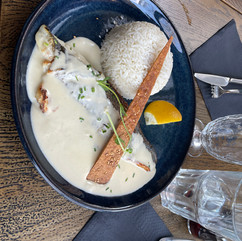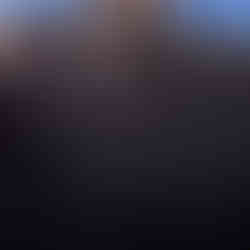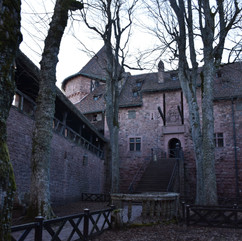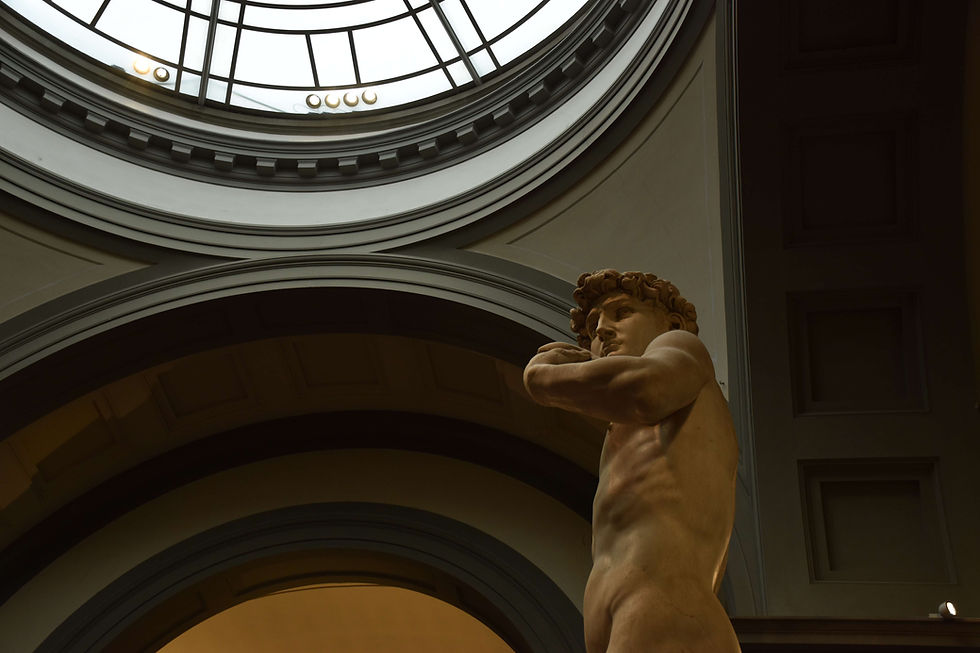Strasbourg and the Alsace Region
- Autumn Mayer
- Feb 7
- 7 min read
Updated: Mar 20
Or Tarte Flambée and Storks
This weekend, I participated in a USAC trip to Strasbourg and the Alsace region in northeastern France! Our train left Gare Part-Dieu around 8:30 on Thursday morning. We arrived in Strasbourg after about four hours and checked into our hotel. I roomed with two other girls, Allison and Regan. We had lunch at the hotel. It was a buffet where you could choose either an appetizer and an entrée or an entrée and a dessert. I thought the crème brûlée with the appetizers was the only dessert option, so that's what I took, along with a baked munster cheese and vegetable entrée. The entrée was good, as it was mostly cheese; the crème brûlée okay but weirdly salty. The desserts had actually been around the corner at the end of the buffet, so the crème brûlée must have been some kind of savory varient.
Around 2 p.m., we met our tour guide, Manon, in front of the Cathédrale Notre-Dame-de-Strasbourg for our guided tour of the city. The cathedral was an imposing structure, begun in the Romanesque style and finished in the Gothic style about 1,000 years ago. The square in front of the cathedral is the windiest place in Strasbourg. Legend has it, Manon told us, that Satan was passing by the cathedral on his horse of wind when he saw himself represented on the cathedral doors, in a scene of sinners in hell on Judgement Day. He went inside to take a closer look and was trapped inside, where he remains to this day. His windy steed still awaits its master outside. Another legend of the cathedral has to do with the storks native to the Alsace region. We all know the story of storks delivering babies, but where do the babies come from? In Alsace, they say the babies' souls come from a place under the crypt of the cathedral, so everyone is originally from Strasbourg! The cathedral also has an astronomical clock with functioning automatons that move every quarter hour; the stages of a man's life walk in front of Death, who rings a bell, and an angel turns an hour glass.
As we walked around the city, Manon gave recommendations and told us about the history of Strasbourg and the Alsace region. The region, unprotected by natural landmarks, has switched between German and French control many times. It was German for a long time, then became French under Louis XIV. It became German again after the French lost the Franco-Prussian war, French after WWI, German during WWII, and French again after WWII. It remains French today. Because of this history, there's a mixture of German and French culture, evident in the architecture and food. There's also Alsatian culture, and the Alsatian language is making a comeback, with schools teaching the language and street signs using both Alsatian and French. After the tour, we climbed 330 steps up the spire of the cathedral, which was exhausting but ultimately worth the incredible view.
We had the evening free. My roommates and I found a restaurant that was open at 5 p.m., a rarity in France, and dined on tarte flambée. Tarte flambée is a traditional Alsatian food that is similar to pizza but with a more delicate crust and white sauce. Ironically, Alsace calls the dish by its French name, and the rest of France calls it flammekueche, its Alsatian name. On the way back to the hotel, we stopped at a pâtisserie Manon had recommended. I got a chocolate mousse cake with nuts for only €4.9, and Regan got an entremet with chocolate biscuit and chocolate cream layers, covered in chocolate ganache. Then we turned in for an early night.
The second day, we had breakfast at the hotel. I had a croissant with apricot jam, a chocolate cappuccino, fruit, and yogurt that was suspiciously lumpy and not very good. Then we departed for a visit of the European Parliament. We needed our passports to get through security and receive our visitor badges. Our guide explained the competition to determine the building's symbolic architecture. The unfinished look to the circular tower represents how the EU is never finished and members can come and go as they please. He also explained that the twelve stars in a circle on the EU's flag represent harmony and unity. Member nations' flags are displayed in diplomatic alphabetical order in each country's name for itself (i.e., Deutschland, not Germany). We visited the chamber where parliament sessions occur and learned about the makeup of the parliament, how members are elected, the various parties, etc.
After the parliament, we walked through the Parc de l'Orangerie. There were swans in the pond and connected river, as well as lots of storks. Then we had lunch at a café. The price of lunch was included in the fee for the trip, paid along with tuition at the beginning of the semester. This meant we could choose whatever dish we wanted without worrying about the individual price. I ordered sea bass with rice and a lemon cream sauce, as well as a coffee afterward. The coffee came with a delicious Biscoff cookie. This was one of if not the best meal I've had so far.
Following lunch, we crossed a park and a bridge over the Rhine. Halfway across the bridge, we entered Germany! The town was called Kehl specifically, though it was only special because it was in Germany. There was no sign to welcome you to Germany, no line in the middle of the bridge to denote the border, and no passport control. The signs were just suddenly in German. We had about half an hour to walk around. My roommates and I found a public restroom and paid the 50¢ to use it; it was surprisingly clean. Then we browsed a souvenir shop, where I bought a postcard. Regan wanted a sketchbook, so we talked to the cashier in French, obviously not knowing any German. It was interesting to speak to a German person in French because she didn't automatically see us as American and switch to English upon hearing our less than fluent French, as a French person typically would. We met back up with the group at the tram stop that would take us back across the border. Stefano and Olga bought us pretzels that we ate while waiting for the tram. They were good but cold, and there was unfortunately no cheese sauce.
*The picture of the swan isn't zoomed in. That swan was literally three feet away from me.
On Saturday, we took a van to Colmar, another city in Alsace. Colmar is known as the birthplace of Frédéric Auguste Bartholdi, the artist that designed the Statue of Liberty. We took a guided tour of the city, visiting a library that was once a convent and the Little Venice neighborhood. We also saw a house that inspired Sophie's house in Howl's Moving Castle. After some free time, during which I bought another postcard, we met back up at a traditional restaurant called Petit Schlossberg. Stefano and Olga ordered tarte flambée for all of us to share, and I got a munster and potato casserole as my main dish, along with apricot juice.
That afternoon, we visited Château du Haut-Koenigsbourg. The castle was built in the 1100s. It was a military installation on a trade route under the Hohenstaufen family of the Holy Roman Empire. The Hohenstaufen line died out, and the castle was besieged and destroyed. It was then rebuilt and expanded by the Counts of Tierstein under the rule of the Habsbourg family. The castle was beseiged and destroyed again by Swedish troops during the Thirty Years' War. Our guide explained that while the castle was important to show power and to collect taxes on a trade route, it wasn't built in a very good location, as there was no strong source of water nearby. The castle was under the control of the French for several centuries but left in ruins. When it came under German control again, Kaiser Wilhelm II had it rebuilt and turned into a museum. Not long after, the castle returned to French control following WWII. The French were able to profit from the rebuilt castle and museum without putting in any restoration effort themselves. Fun fact: some of the furniture in the castle inspired design elements in The Hobbit and The Lord of the Rings.
We returned to Strasbourg and had the evening free. I decided to go shopping with a group of other girls at the Galeries Lafayette, a large department store chain in France. Some of the others had been there the previous day and seen some good sales, so I thought I would have a chance at finding a reasonably priced black wool coat. Unfortunately, while there were sales, the starting price on the cheapest coat was still over €200; some of the more expensive ones were €500 or even €600. I didn't end up getting anything. On the way back to the hotel, I finally had a chance to try French tacos! French tacos are nothing like the tacos we're used to in the US. It's more like a grilled wrap with your choice of meat, sauce, and vegetables, and they all come with fries inside. It was pretty good!
On the final day of the trip, we had a little bit of a later start to the morning. We checked out of the hotel and went to the Musée des Beaux-Arts. There were three floors: one for artwork, one for interior design, and one for archeology. After browsing the museum, we were free for lunch. My roommates and I found a café and had pretzels with cheese and bacon, as well as coffee. We browsed a pain d'épices store on the way back to the hotel. Pain d'épices translates as "gingerbread," but it's really any kind of spiced bread/biscuit/cookie. I got a package of pains d'épices fourrés crème de praliné: a chewy spiced cookie filled and covered with chocolate. Then it was time to hop back on the train to return to Lyon! In a way, it was odd to return. When we departed for Strasbourg, Lyon had still felt like a vacation. But when we returned from vacation in Strasbourg, Lyon felt familiar, like home.
.jpg)



























































Comments